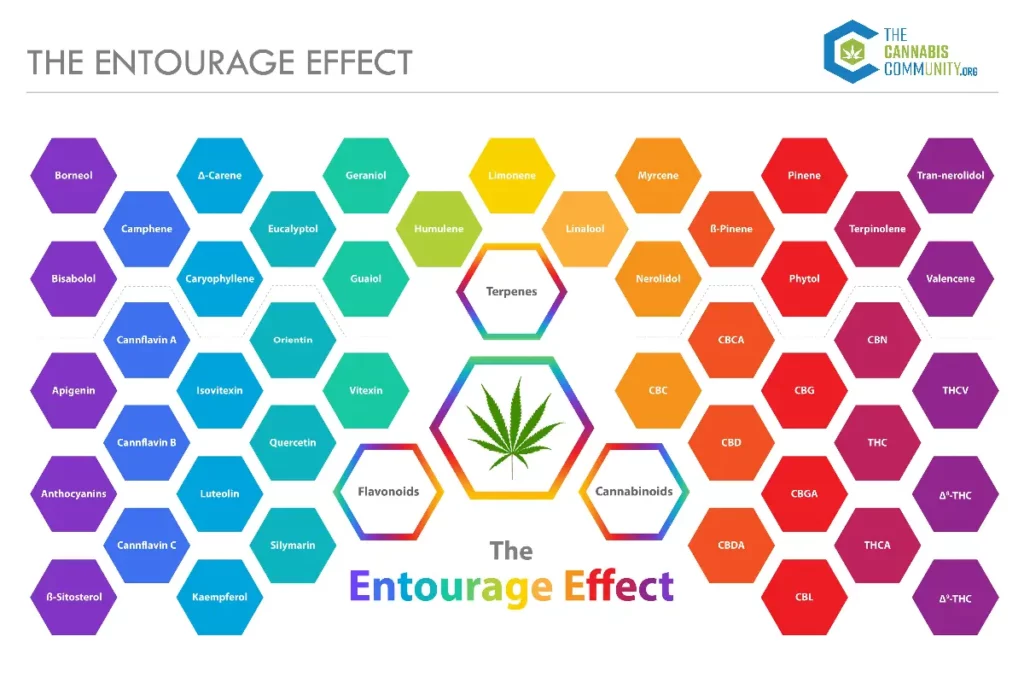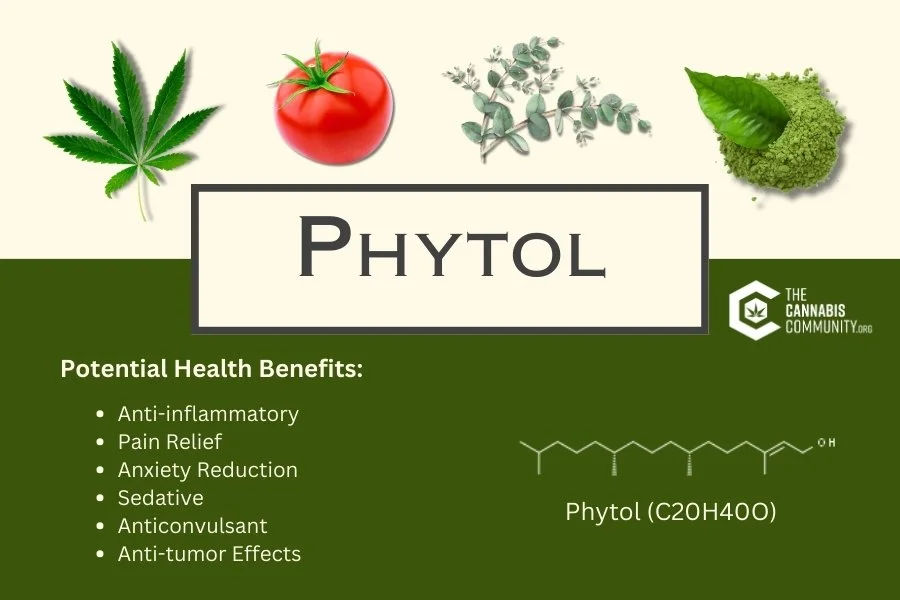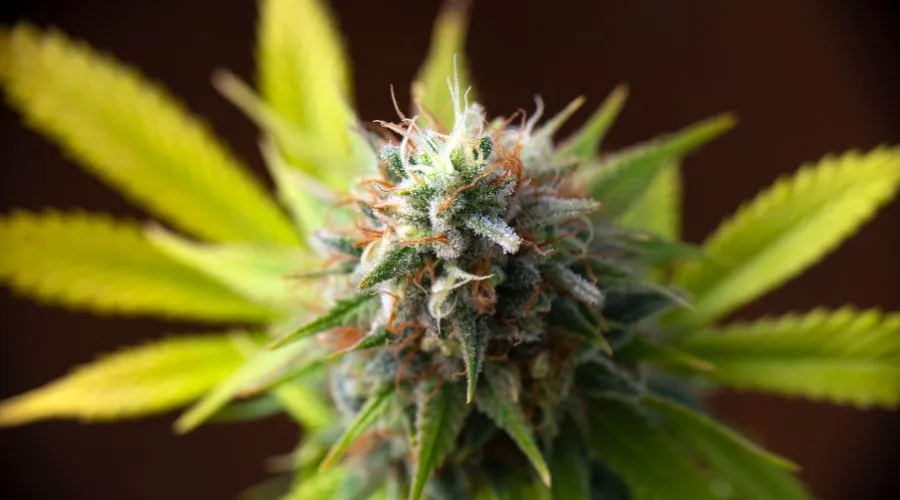Phytol: What You Need To Know About This Cannabis Terpene
Table of Contents
When it comes to cannabis, there is much more to it than just THC and CBD. The cannabis plant is rich in various compounds — including terpenes — which contribute to its unique aroma and effects.
One such terpene is phytol, which has been gaining attention for its potential therapeutic benefits.
In this article, we will delve into the world of phytol, examining its role in cannabis, its properties, and its potential applications for health and wellness.
What Are Terpenes?

Terpenes are natural chemical compounds found in plants and even some animals, which are responsible for the diverse scents, flavors, and colors associated with various types of vegetables.
In the context of cannabis, terpenes are pivotal in creating the distinct aromas and tastes that differentiate one strain from another.
While their precise role in human physiology remains enigmatic, terpenes are increasingly recognized as key players in the classification of cannabis products and predicting their effects.
The leading hypothesis suggests that a strain’s terpene profile, in combination with its cannabinoid content — like THC and CBD —, collaboratively produces the characteristic effects associated with different strains, shedding light on why strains with similar THC levels can deliver notably different experiences.
While terpenes themselves do not induce a traditional high, some are considered psychoactive due to their influence on the brain. They are believed to modulate the effects of THC, the primary psychoactive cannabinoid in cannabis.
This discovery challenges the predominant focus on THC content when selecting a strain. Instead, experts advocate for an emphasis on specific terpene profiles to achieve desired effects.
Although ongoing research reveals promising links between certain terpenes and mental health conditions — such as anxiety and depression — it is important to acknowledge that our understanding of terpenes is still in its early stages and needs further comprehensive investigations to unveil their full potential in the world of cannabis.
What Is The Entourage Effect?
The “Entourage Effect” is a pivotal concept in the realm of cannabis products emphasizing the importance of the holistic interplay of compounds within the cannabis plant.
Whether it’s phytocannabinoids or terpenes, the Entourage Effect posits that these compounds function most effectively when working together in synergy.

This collaborative interaction is believed to yield a more comprehensive impact on an individual’s well-being, encompassing diverse benefits ranging from anxiety relief to inflammation reduction.
At its core, the Entourage Effect is when one compound interacts with a spectrum of compounds, rather than existing in isolation. Terpenes — prevalent in cannabis — contribute not only to their distinct aromas but also to potential health advantages.
For instance, limonene — present in lemon peels — has garnered attention for its mood-enhancing properties when combined with CBD, while pinene — derived from pine resin — may heighten alertness.
What Is Phytol?
Phytol is an acyclic diterpene alcohol that can be found in various sources, including green tea and the cannabis plant. It’s a colorless, oily liquid that is derived from the breakdown of chlorophyll during the extraction process.
Phytol is just one of the many terpenes present in cannabis, each contributing to the plant’s distinctive scent and potential effects.
While research on phytol is still in its early stages, preliminary studies suggest that this terpene may offer several therapeutic benefits.
Studies have hinted at phytol’s anti-inflammatory properties, making it a potential candidate for managing conditions associated with inflammation.
Evidence suggests that phytol could have analgesic properties, potentially relieving those living with chronic pain.
Phytol isn’t distributed evenly across all cannabis strains. Some strains may boast high levels of phytol, giving them a more grassy aroma, while others may contain lower concentrations.
It’s crucial to note that the presence of phytol in a strain doesn’t necessarily dictate its therapeutic effects, as the interplay between various terpenes and cannabinoids also plays a significant role in shaping the overall experience.
Chemical Structure of Phytol
Understanding the chemical structure of phytol provides valuable insights into its biological functions and potential applications.
Phytol (C20H40O) is a chemical compound with a molecular weight of 296.531 g/mol. Its IUPAC name is “(2E,7R,11R)-3,7,11,15-tetramethylhexadec-2-en-1-ol.” The compound has a complex structure with multiple carbon atoms and hydrogen atoms, forming a long hydrocarbon chain. It also contains a double bond and a hydroxyl group, making it an alcohol. Phytol is characterized by its 20 carbon atoms, 40 hydrogen atoms, and one oxygen atom.
The hydroxyl group at the end of the molecule makes phytol a lipophilic compound, meaning it is soluble in fatty substances.
This structure plays a crucial role in phytol’s function as a precursor for the synthesis of other compounds, such as vitamin E, chlorophyll, and plastoquinone in plants.

What Are the Effects of Phytol?
Phytol has garnered attention for its potential health benefits and therapeutic properties. The effects and potential health benefits of the terpene phytol include:
- Anti-Inflammatory: Phytol may have anti-inflammatory properties, making it useful in managing conditions marked by inflammation, such as arthritis and psoriasis.
- Pain Relief: Phytol’s anti-inflammatory properties may translate into pain relief, offering a potential natural analgesic effect.
- Anxiety Reduction: Studies suggest that phytol may help reduce anxiety levels, possibly through interactions with the GABAergic system, which plays a role in mood regulation.
- Sedative: Phytol exhibits sedative properties, making it a potential aid for individuals struggling with sleep difficulties.
- Anticonvulsant: Preliminary research indicates that phytol may help control seizures by modulating neurotransmitters, but further investigation is needed.
- Anti-Tumor Effects: Early-stage cell studies suggest that Phytol has potential anti-tumor properties, particularly in the context of liver cancer treatment. However, extensive research is required to confirm its efficacy as a cancer treatment.
While phytol shows promise in these areas, more research is needed to fully understand its effects and mechanisms of action. There are potential risks associated with vaping phytol, such as lung damage. Caution and consultation with healthcare professionals are advisable when considering its use for health benefits.
What Cannabis Strains Are High In Phytol?

Although commonly found in green tea and matcha products, phytol is also naturally occurring in select cannabis strains such as:
- Sour Diesel
- Cheese
- OG Kush
- Strawberry Diesel
- Banana Kush
- Jack Herer
- Girl Scout Cookies
- Blue Cheese
- Super Lemon Haze
- Skywalker OG
Where Can You Find Phytol Terpenes Besides Cannabis?

While it is commonly associated with cannabis, phytol can also be found in various other natural sources, such as:
- Green Tea
- Ripe tomatoes
- Carrots
- Green leafy vegetables like spinach and kale
- Eucalyptus
- Peppermint oil
Whether you’re exploring phytol through cannabis strains or incorporating it from other natural sources, the potential health benefits of this compound make it a captivating subject of study and a valuable addition to holistic well-being.
Please tell us your thoughts about phytol and cannabis. Do you think there’s a connection between the mental alertness some find in green tea and certain strains of cannabis? Both are favorites for us!
Leave us your comments and questions.
Get Your Medical Cannabis Card Online and in Minutes
Back to Directory



